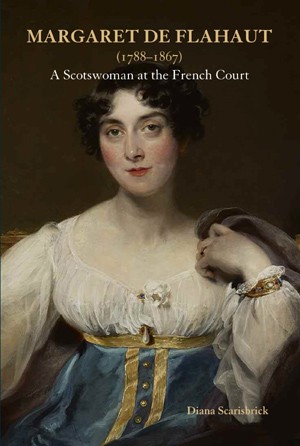Publisher’s presentation:
Margaret Mercer Elphinstone (1788–1867), with her powerful mind and independent spirit, was never daunted by adversity as she sought to realize her ambitions for her family against the background of intellectual upheaval and social and political change which followed the French Revolution and the end of the ancien régime. The turning-point in her life was her controversial marriage in 1817 with the general Charles de Flahaut (1785–1870), which, contrary to all expectations, resulted in one of the most successful partnerships in the ‘auld alliance’ between France and Scotland.
Margaret was also a skilled draughtswoman and painter. Eight of her colourful portrait miniatures are featured in the book.
The political and social worlds of France, England and Vienna during the period which began with the French Revolution and ended with the Second Empire are engagingly seen through the eyes of a highly intelligent Scotswoman, Margaret Mercer Elphinstone, comtesse de Flahaut.
Whereas the life of her husband, the dashing Napoleonic general and diplomat Charles de Flahaut, is well known, Margaret has remained in the shadows. Yet this biographical study, based on unpublished and intimate correspondence in the Archives Nationales, Paris, reveals her to have been the more interesting of the two. It shows how much he depended on her brains, political judgment and artistic taste as well as her fortune to guide him in his career. More than that, their letters to each other also confirm that she made a success of her controversial marriage and that the bond between them was strengthened through all the vicissitudes of their life together. A faithful and sincere friend, she could be an implacable enemy: Talleyrand’s companion, the duchesse de Dino, whom she dubbed ‘that horrid little serpent’, and the Duke of Wellington, ‘that bully’, were favourite targets.
Her lively, observant but wicked pen takes us with her on visits to Talleyrand at Valençay, to the marquis de Lafayette, to the duchesse de Praslin at Vaux-le-Vicomte, to house parties in stately homes of England and Scotland – Arundel, Woburn, Bowood, Chatsworth, Grimsthorpe and Drummond Castle. Acknowledged a superb hostess, her descriptions of the menus, and entertainments organized in her homes in Scotland, London, and Paris and at the Flahaut embassies in Vienna and in London capture the flavour of those cosmopolitan gatherings. Her guests were also drawn to the display of her fine French furniture and collection of works of art, acquired during her years in Paris, which set a new fashion in decoration. Interesting, too, are her accounts of sightseeing in Rome before the city of the Grand Tour changed into the capital of united Italy. The enjoyable social life in the continental watering places is also described, for Margaret believed in the curative effects of spas.
A lifelong liberal in politics and an upholder of Whig principles, her politicomanie inspires sharp comments on the opponents of Reform in England and on the self-seeking ministers of Louis-Philippe in France. Unusually, for a British woman, the daughter of Admiral Keith, an inveterate enemy of the French, she shared her husband’s admiration for Napoleon and joined with him in supporting Napoleon III.
Born before her time she could have made a name for herself in today’s world as a professional artist or politician in her own right. As it was, she used her talents to become an expert in the art of living the life so amusingly and vividly evoked in letters to her husband, her children and her close friends. These relationships, which are the heart of the book, are presented to the reader by an English woman historian, herself a Francophile.
Contents
|
The Admiral’s Ambitious Daughter
|
About the Author
Diana Scarisbrick, FSA, is a historian specialising in jewellery and engraved gems. She has curated exhibitions in the United Kingdom and abroad and has written many books, including, more recently, Rings: Jewelry of Power, Love and Loyalty (2007) and Portrait Jewels: Opulence and Intimacy from the Medici to the Romanovs (2011). For many years she was the historian of Chaumet, the great Parisian jeweller. As research associate at the Beazley Archive, Oxford, she collaborated with Professor Sir John Boardman and Claudia Wagner on The Beverley Collection of Gems at Alnwick Castle (Philip Wilson Publishers, 2016). In 2014 she published with Benjamin Zucker the biography of Elihu Yale (Thames & Hudson). Her forthcoming history of diamond jewellery (Diamond Jewelry: 700 Years of Glory and Glamour, ISBN 978-0-500-02150-7) will be published by Thames & Hudson in September 2019.


